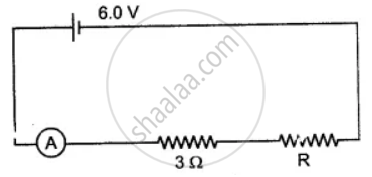Advertisements
Advertisements
प्रश्न
A p.d. of 10 V is needed to make a current of 0.02 A flow through a wire. Wire p.d. is needed to make a current of 250 mA flow through the same wire?
उत्तर
wire.
So potential difference, V = 10 V
Current, I = 0.02 A
Resistance of the wire, R = V/I
R = 10/0.02 = 500 Ω
The resistance will remain the same unless the wire is changed.
Now to make a current of 250 mA to flow through the wire, the potential difference required is:
V = IR
V = 250 x 10-3 x 500
V = 125 V
So a potential difference of 125 V is needed to make a current of 250 mA flow through the wire.
APPEARS IN
संबंधित प्रश्न
Potential difference is measured in _________ by using a ___________ placed in ___________ across a component.
The unit for measuring potential difference is:
A resistance of 20 ohms has a current of 2 amperes flowing in it. What potential difference is there between its ends?
Define the unit of resistance (or Define the unit "ohm").
Calculate the power used in the 2 Ω resistor in each of the following circuits: a 4 V battery in parallel with 12 Ω and 2 Ω resistors.
A current of 0.2 A flows through a wire whose ends are at a potential difference of 15 V. Calculate:
(i) The resistance of the wire, and
(ii) The heat energy produced in 1 minute.
The figure shows a circuit. When the circuit is switched on, the ammeter reads 0.5 A.

(i) Calculate the value of the unknown resistor R.
(ii) Calculate the charge passing through the 3 Ω resistor in 120 s.
(iii) Calculate the power dissipated in the 3 Ω resistor.
A current of 0.2 A flows through a conducting wire for 5 minutes. How much charge will flow?
A battery of 10 volt carries 20,000 C of charge through a resistance of 20 Ω. The work done in 10 seconds is:
A negative charge will move from ______ to ______ potential.
